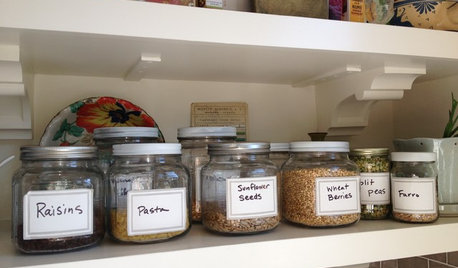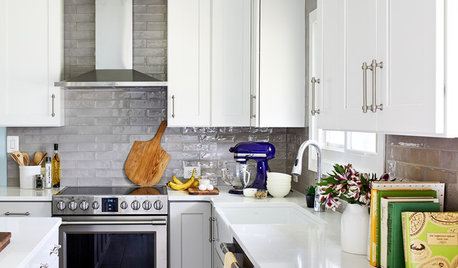Why do jars crack sometimes?
n1st
13 years ago
Related Stories

CONCRETEWhy Concrete Wants to Crack
We look at the reasons concrete has a tendency to crack — and what you can do to help control it
Full Story
PATIOSPatio Details: Good-bye Cracked Concrete, Hello Lush Garden
A San Francisco couple replace an old parking space with a barefoot-friendly outdoor retreat for eating, entertaining and play
Full Story
DECORATING GUIDESStorage Style: Apothecary Jars
Tall Footed Jars Turn Your Stuff Into Decor
Full Story
KITCHEN STORAGEArtful Organizers: Jars for Pretty Pantry Displays
Ditch the disheveled look of mismatched boxes and bags for colorful or clear pantry jars in an appealing arrangement
Full Story
FIREPLACESConcrete Panels Create a Stylish Modern Fireplace
A dozen distressed custom panels form a cohesive look without the mass that can sometimes lead to cracking
Full Story
KITCHEN DESIGNGet Organized for Holiday Baking
Before you crack that first egg, establish a game plan for stress-free success
Full Story
REMODELING GUIDESFinishing Touches: Pro Tricks for Installing Fixtures in Your Tile
Cracked tile, broken drill bits and sloppy-looking fixture installations? Not when you follow these pro tips
Full Story
LANDSCAPE DESIGNOutdoor Style: Creative Ways With Classic Concrete
Have you cast concrete aside as being too dull or crack-prone? Learn about new design options along with the basics of using it outside
Full Story
TASTEMAKERSCatch the Intrepid Design Spirit, Courtesy of Brian J. McCarthy
Crack open the designer's new book and discover how to create interiors that 'crackle with excitement'
Full Story
HOLIDAYSA Thanksgiving Tradition to Last the Whole Year
Looking for a thoughtful yet simple way to capture your family's gratitude? Grab a jar and paper
Full Story





digdirt2
n1stOriginal Author
Related Professionals
Franconia Landscape Architects & Landscape Designers · Grand Haven Landscape Architects & Landscape Designers · Middle River Landscape Architects & Landscape Designers · Washington Landscape Architects & Landscape Designers · Amesbury Landscape Contractors · Cedar Hill Landscape Contractors · Chattanooga Landscape Contractors · Dudley Landscape Contractors · Pahrump Landscape Contractors · Waltham Landscape Contractors · Ferguson Landscape Contractors · Dallas Roofing & Gutters · Sarasota Roofing & Gutters · Cincinnati Roofing & Gutters · Wildomar Driveway Installation & Maintenancereadinglady
digdirt2
Linda_Lou
mapleleafquilt
n1stOriginal Author
Linda_Lou
unionmaid
Trishcuit